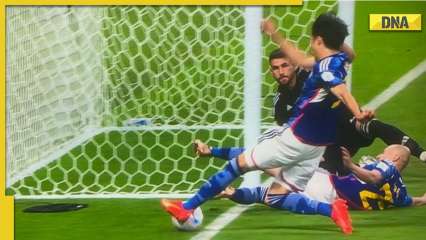Explainer: Why was Japan’s controversial 2nd goal against Spain allowed by VAR?

The Group E in the 2022 FIFA World Cup turned out to be the “Group of Death”, with Japan beating both Germany and Spain to qualify for the Round of 16 as group winners. While Spain progressed as runners-up due to a better goal difference, 2014 champions Germany were knocked out.
READ: IPL 2023: Franchises asked to submit final list of shortlisted players by December 9
Japan’s Ao Tanaka scored in the 51st minute against Spain to give the lead to the Blue Samurais in the Group E game. The goal underwent a lengthy VAR check but stood as the referees found the ball to not have crossed the touchline.
The ball was delivered from the right side of the field and Kaoru Mitoma got behind it. The ball, however, seemed to have crossed the touchline, and gone out of play, before the Japan player stopped it.
The FIFA World Cup games have the semi-assisted offside technology to judge decisions like these. The ruling for the point of contention in today’s game was that the ball had not crossed the touchline.
The decision put the Asian team in the lead. Japan trailed 0-1 at the half way mark before Ritsu Doan put the team level.
This second goal for Japan had major repercussions in Group E. Japan held on to the lead which eventually knocked out Germany.
The win put Japan at six points while Germany could only reach four. However, had the goal been disallowed, Japan would have been on four points. In this case, Germany would have qualified by virtue of more goals scored, after its 4-2 win over Costa Rica.
READ: Umran Malik replaces injured Mohammad Shami in India’s ODI squad against Bangladesh
Why did VAR rule the decision in Japan’s favour?
It has to be understood that even though the ball might have been placed on ground beyond the touchline, it’s tangent was inside the permissible limit. Hence, a part of the ball was in-line with the touchline, prompting the officials to call it a legitimate goal.
FIFA claimed that the “curvature of the ball” remained in, hence the ball was not out of play at that moment.
According to IFAB, who set the laws of the game, the ball is out when “it has wholly passed over the goal line or touchline on the ground or in the air”.
The goal turned out to be the one that resulted in Germany’s elimination from the tournament. Despite securing a 4-2 win against Costa Rica in a topsy-turvy match, Germany couldn’t progress to the Round of 16. Japan, on the other hand, book their spot in the knockouts as winners of Group E.
For all the latest Sports News Click Here

